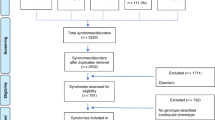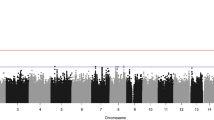Abstract
Mutations of FLNA, an X-linked gene that encodes the cytoskeletal protein filamin A, cause diverse and distinct phenotypes including periventricular nodular heterotopia and otopalatodigital spectrum disorders (OPDS). Craniofacial abnormalities associated with OPDS include supraorbital hyperostosis, down-slanting palpebral fissures and micrognathia; craniosynostosis was previously described in association with FLNA mutations in two individual case reports. Here we present four further OPDS subjects who have pathological FLNA variants and craniosynostosis, supporting a causal link. Together with the previously reported patients, frontometaphyseal dysplasia was the most common clinical diagnosis (four of six cases overall); five patients had multiple suture synostosis with the sagittal suture being the most frequently involved (also five patients). No genotype–phenotype correlation was evident in the distribution of FLNA mutations. This report highlights the need to consider a filaminopathy in the differential diagnosis of craniosynostosis, especially in the presence of atypical cranial or skeletal features.
Similar content being viewed by others
Log in or create a free account to read this content
Gain free access to this article, as well as selected content from this journal and more on nature.com
or
References
Eksioglu YZ, Scheffer IE, Cardenas P et al: Periventricular heterotopia: an X-linked dominant epilepsy locus causing aberrant cerebral cortical development. Neuron 1996; 16: 77–87.
Gargiulo A, Auricchio R, Barone MV et al: Filamin A is mutated in X-linked chronic idiopathic intestinal pseudo-obstruction with central nervous system involvement. Am J Hum Genet 2007; 80: 751–758.
Bernstein JA, Bernstein D, Hehr U, Hudgins L : Familial cardiac valvulopathy due to filamin A mutation. Am J Med Genet A 2011; 155A: 2236–2241.
Reinstein E, Frentz S, Morgan T et al: Vascular and connective tissue anomalies associated with X-linked periventricular heterotopia due to mutations in filamin A. Eur J Hum Genet 2013; 21: 494–502.
Robertson SP, Twigg SR, Sutherland-Smith AJ et al: Localized mutations in the gene encoding the cytoskeletal protein filamin A cause diverse malformations in humans. Nat Genet 2003; 33: 487–491.
Dudding BA, Gorlin RJ, Langer LO : The oto-palato-digital syndrome. A new symptom-complex consisting of deafness, dwarfism, cleft palate, characteristic facies, and a generalized bone dysplasia. Am J Dis Child 1967; 113: 214–221.
Young K, Barth CK, Moore C et al: Otopalatodigital syndrome type II associated with omphalocele: report of three cases. Am J Med Genet 1993; 45: 481–487.
Robertson S, Gunn T, Allen B, Chapman C, Becroft D : Are Melnick-Needles syndrome and oto-palato-digital syndrome type II allelic? Observations in a four-generation kindred. Am J Med Genet 1997; 71: 341–347.
Robertson SP, Jenkins ZA, Morgan T et al: Frontometaphyseal dysplasia: mutations in FLNA and phenotypic diversity. Am J Med Genet A 2006; 140: 1726–1736.
Foley C, Roberts K, Tchrakian N et al: Expansion of the spectrum of FLNA mutations associated with Melnick-Needles syndrome. Mol Syndromol 2010; 1: 121–126.
Sun Y, Almomani R, Aten E et al: Terminal osseous dysplasia is caused by a single recurrent mutation in the FLNA gene. Am J Hum Genet 2010; 87: 146–153.
Rossi M, Jones RL, Norbury G et al: The appearance of the feet in Pfeiffer syndrome caused by FGFR1 P252R mutation. Clin Dysmorphol 2003; 12: 269–274.
Pitteloud N, Quinton R, Pearce S et al: Digenic mutations account for variable phenotypes in idiopathic hypogonadotropic hypogonadism. J Clin Invest 2007; 117: 457–463.
Savarirayan R, Cormier-Daire V, Unger S et al: Otopalatodigital syndrome, type II: report of three cases with further delineation of the chondro-osseous morphology. Am J Med Genet 2000; 95: 193–200.
Adzhubei IA, Schmidt S, Peshkin L et al: A method and server for predicting damaging missense mutations. Nat Methods 2010; 7: 248–249.
Clark AR, Sawyer GM, Robertson SP, Sutherland-Smith AJ : Skeletal dysplasias due to filamin A mutations result from a gain-of-function mechanism distinct from allelic neurological disorders. Hum Mol Genet 2009; 18: 4791–4800.
Acknowledgements
We thank Michael Oldridge for genetic analysis and the Wellcome Trust (102731 to AOMW) and Curekids NZ (SPR) for funding.
Author information
Authors and Affiliations
Corresponding author
Ethics declarations
Competing interests
The authors declare no conflict of interest.
Rights and permissions
About this article
Cite this article
Fennell, N., Foulds, N., Johnson, D. et al. Association of mutations in FLNA with craniosynostosis. Eur J Hum Genet 23, 1684–1688 (2015). https://doi.org/10.1038/ejhg.2015.31
Received:
Revised:
Accepted:
Published:
Issue date:
DOI: https://doi.org/10.1038/ejhg.2015.31
This article is cited by
-
Apert syndrome: magnetic resonance imaging (MRI) of associated intracranial anomalies
Child's Nervous System (2018)
-
Otopalatodigital spectrum disorders: refinement of the phenotypic and mutational spectrum
Journal of Human Genetics (2016)



